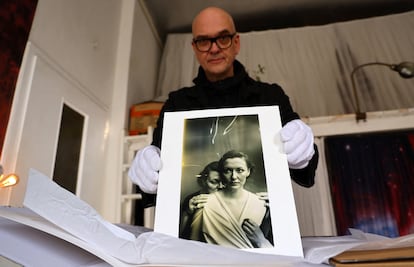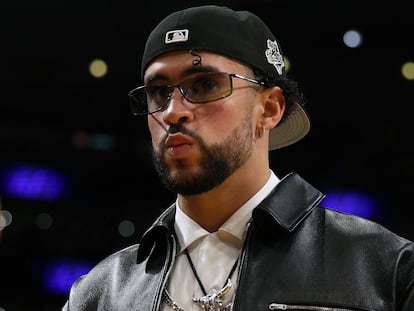AI in art: Creativity or plagiarism?
For many, artificial intelligence is a tool, like Photoshop or a paintbrush. For others, it is urgent to put a stop to what they consider a theft and raise a question: what is considered art?

Last year, the German artist Boris Eldagsen won the Sony World Photography Award in the creativity open category with an image generated with artificial intelligence. Pseudomnesia: The Electrician thus became the first ever AI-generated image to win a photography contest. Eldagsen said that when the prize committee told him that he had won, he admitted that the photo had been made with DALL-E, and that if they still wanted to award him the prize, they needed to open a discussion about the problems involved with using AI in art.
Although the committee allowed him to keep the award, it did not open a debate or address how the winning image had been created, which prompted the artist to take a stand publicly. “AI is not photography. Therefore, I will not accept the award,” said Eldagsen during his address at the award ceremony, which also highlighted the importance of transparency.
Eldagsen triggered an international debate on the use of AI in art, and quickly sparked change in the art world. In November, the World Press Photo — considered the most prestigious photojournalism contest in the world — modified its rules to prohibit the use of AI in all its categories, even in the Open Format category, where it had been previously allowed.
“Art is dead. It’s over. AI won. Humans lost,” Jason M. Allen, an American video game designer, told The New York Times in 2022, after being declared the winner of the Colorado State Art Fair’s competition in the category of “emerging digital artists.” He had won the prize with a work titled Théâtre d’Opéra Spatial, which was made using Midjounrey, an AI system that creates images based on text prompts.
But for Noam Segal, the artistic curator of the Guggenheim, “the issue does not lie in the production tool, but rather in the conceptual and material involvement of the artist, whether computational or material-based. AI image generation can be a form of conceptual art and can also a mere technique.” As he explains by email, each artwork is a world on to itself, and the question must be considered on a case-by-case basis.
In Spain, the SOLO Collection has created more than 50 artworks with AI, including the first AI-generated image auctioned at Sotheby’s: Memories of Passersby I. The collective — a leader in artist experimentation — has just launched the second call for the SOLO AI AWARD ‘24 international competition, which is supported by Goldsmiths University and Google Arts & Culture. The prize awards €10,000 ($10,900) to the artist of the most innovative works created with AI. According to its creative director, Óscar Hormigos, AI is just another tool, like Photoshop or a paintbrush.
Lev Manovich, director of the Cultural Analytics Laboratory and presidential professor at the City University of New York Graduate Center, agrees with this argument. “AI image generators will soon be seen as normal, as happened with all tools previous techniques,” he explains via email. “Not everyone who uses AI tools to create art are artists, just as everyone who takes photos aren’t photographers.”
The book Artificial Aesthetics. A Critical Guide to AI, Media and Design, which was co-written by Manovich, explains that, although AI allows humans to automate the process of creating art, the result will depend on the person’s aesthetic sensitivity. “Conservative views on art consider technical mastery as a criterion for ‘real art,’” it states. “‘My kid could have done that!’ — the popular cliché directed at contemporary art — seems now, in an ironic reversal, to turn against the great and stylistically complex — but computationally scalable — art of cultural tradition: even an AI could do that. It is the Duchamp that remains outside of AI’s creative abilities, at least for now.”
With his famous urinal, Marcel Duchamp was one of the first artists to question what can be considered art. According to the Frenchman, the precursor of conceptual art, art is what the artist says it is. It’s a definition backed by Miguel Oliveros, an interdisciplinary artist and professor at the Video Games and Applications Laboratory at the Nebrija University in Spain, who has been making art for 20 years using self-programmed applications. “The natural development of contemporary art is for it to move from object to process,” he explains in an audio message. “For me, all types of creation that use technology are processes, not objects: the object is part of the process. In other words, I am not interested in the image, but in the system, especially if it is programmed in open source.”
But ethical problems arise if artists — instead of working with their own work — use AI-generated images. Many use Laion-5B, a nonprofit public database that includes millions of copyrighted images from the internet. This is copyright infringement, since the images are used without the creator’s consent. Their work is feeding AI systems, but the artist receives no financial compensation or recognition of authorship.
This is what happened to three American artists — Kelly McKernan, Sarah Andersen and Karla Ortiz — who filed a class action suit against Midjourney, Stable Diffusion and DreamUp after seeing their names appear in requests to create digital works in a certain style. The case has been dismissed on several occasions, but the artists continue to fight. For her efforts to protect artists’ copyright, Kelly McKernan was listed by Time magazine as one of the 100 most influential people in AI in 2023. Companies are also suing. Getty Images took Stability AI to court for using millions of its copyrighted photos and infringing its watermark. Both cases are yet to be resolved.
The movement Support Human Artists - AI is Theft is also taking a stand against private entities that illicitly appropriate artwork for profit. Many believe these companies are committing large-scale plagiarism and getting away scot-free. In view of this problem, the Art is Ethics collective has collected more than 5,200 signatures to regulate AI in Latin America and Spain. “If, as active members of society, we do not assert our rights [...] this situation will continue to worsen, in which the devaluation of what is ‘remixed’ by machines is imposed over the original value of what is created by people,” the collective states in their manifesto.
“This practice of working from the appropriation of content is the result of the hypercapitalist system in which we live, where comfort prevails,” adds Oliveros.
In response to the lawsuits, AI developers have argued that their datasets are protected by the “fair use” doctrine in copyright law, which allows a copyrighted work to be used in a transformative way, which makes sense in the training of image generators.
For Óscar Hormigos, the main problem is that it will become impossible to differentiate between what is real and what is created by AI. “We are in a very nascent moment; it is not the time for answers, it is the time to ask ourselves the right questions to build the use of AI that we want.”
Sign up for our weekly newsletter to get more English-language news coverage from EL PAÍS USA Edition
Tu suscripción se está usando en otro dispositivo
¿Quieres añadir otro usuario a tu suscripción?
Si continúas leyendo en este dispositivo, no se podrá leer en el otro.
FlechaTu suscripción se está usando en otro dispositivo y solo puedes acceder a EL PAÍS desde un dispositivo a la vez.
Si quieres compartir tu cuenta, cambia tu suscripción a la modalidad Premium, así podrás añadir otro usuario. Cada uno accederá con su propia cuenta de email, lo que os permitirá personalizar vuestra experiencia en EL PAÍS.
¿Tienes una suscripción de empresa? Accede aquí para contratar más cuentas.
En el caso de no saber quién está usando tu cuenta, te recomendamos cambiar tu contraseña aquí.
Si decides continuar compartiendo tu cuenta, este mensaje se mostrará en tu dispositivo y en el de la otra persona que está usando tu cuenta de forma indefinida, afectando a tu experiencia de lectura. Puedes consultar aquí los términos y condiciones de la suscripción digital.











































